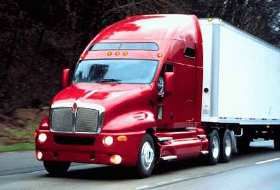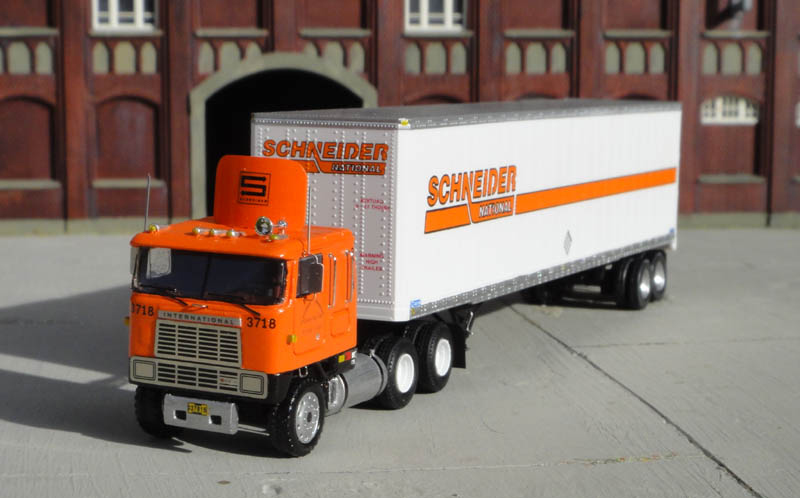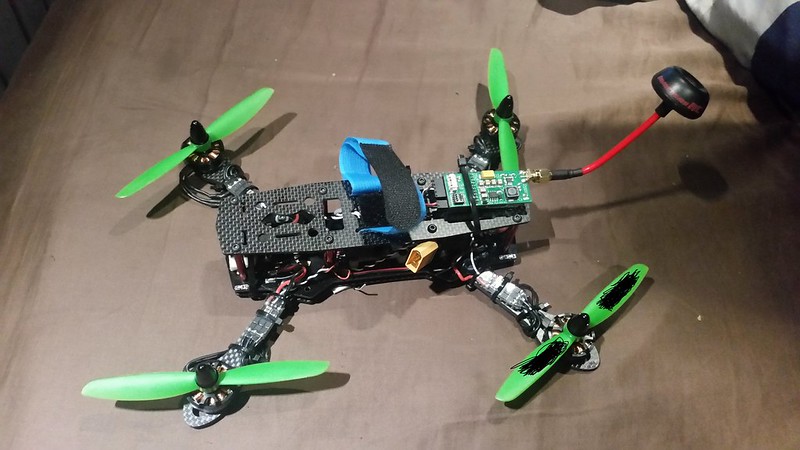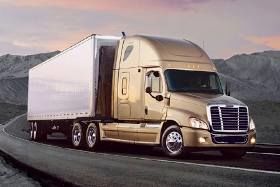Tractor-Trailer Stuck Under Bridge
Topic 11953 | Page 3
My truck's clearance is 13' due to a shorter cab and shorter trailer.
Dave
That guy's clearance is now 11'4", for the same reason.
I think one thing I think people need to understand is MOST box/dry vans and reefers are 13'6". MOST tractors pulling said trailers are 13'6". Some flat bed trucks have a lower profile, and can drive under a 13' bridge EMPTY. Same with some grain hopper trailers. However, I don't know of any tractor that can clear a bridge lower than 12'.
Dave
I understand, I was just joking (about that guy''s trailer being shorter now, not about yours), but I guess it's not as funny as itvseemedvto me.
Dry Van:
A trailer or truck that that requires no special attention, such as refrigeration, that hauls regular palletted, boxed, or floor-loaded freight. The most common type of trailer in trucking.Reefer:
A refrigerated trailer.

Here I am trying to defend swift and it's drivers because I don't believe they are as bad as people make them sound and then a swift drive goes and does this.
I'm starting to question their training tbh... the next we need to figure out... what locations did these bad drivers train out of... maybe it's not swift in general but maybe a specific location or even a specific trainer who's forgetting to teach things.
Seriously? Like this mistake is only made by Swift drivers? How much training is required to instruct a student not to drive under a bridge marked 11' clearance with their 13' 6" high trailer? Please...it's a permit question.

Here I am trying to defend swift and it's drivers because I don't believe they are as bad as people make them sound and then a swift drive goes and does this.
I'm starting to question their training tbh... the next we need to figure out... what locations did these bad drivers train out of... maybe it's not swift in general but maybe a specific location or even a specific trainer who's forgetting to teach things.
Seriously? Like this mistake is only made by Swift drivers? How much training is required to instruct a student not to drive under a bridge marked 11' clearance with their 13' 6" high trailer? Please...it's a permit question.
Saying Swift is the worst does not work. Their safety record is excellent- their percentages of accidents are the same as other companies. The only reason they are in the news more is because they have about 13, 800 drivers. When I trained at Prime in June 2015, they had about: 7,000 drivers, 5,000 trucks- more drivers than trucks because of teams.

I know what it was.... the bridge was about to fall on an entire family of kittens and smash them all. This driver saved the lives of the entire family because Timmy and Lassie had just run under the bridge to rescue them and they would have not had the time to get out before it collapsed.

So, I was looking at the map coordinates. I'm not a driver yet, so was wondering how should he have gone? all the bridges in this area can't clear 13'6". I would have tried the bridge on 80, but it isn't even marked. If 80 was the best way, how do you trip plan for that if you had drops on the west side of the tracks and then move to do drops on the east side? are you supposed to googlemaps everplace you go? Yes, I know he should have seen the sign. I'm asking about trip planning more than what he did wrong.

Obviously he wasnt going fast enough or he would have made it out the other side LOL

Obviously he wasnt going fast enough or he would have made it out the other side LOL
Seems legit 

So, I was looking at the map coordinates. I'm not a driver yet, so was wondering how should he have gone? all the bridges in this area can't clear 13'6". I would have tried the bridge on 80, but it isn't even marked. If 80 was the best way, how do you trip plan for that if you had drops on the west side of the tracks and then move to do drops on the east side? are you supposed to googlemaps everplace you go? Yes, I know he should have seen the sign. I'm asking about trip planning more than what he did wrong.
In my humble opinion, drivers should plan each one of their trips, as well as modify each trip when it is necessary. In this particular case, I would have planned my trip to include the stops on the west side of the tracks and, then, I would have found a safe, truck-friendly route back to the interstate (that's where the driver said he was going) through an inquiry with people familiar with the area, or a review of my map. Had I been carrying Rand McNally's Motor Carrier Edition, I would have looked at it for such obstructions as low overpasses -- like rairoad bridges.
So, I suppose to put it as simply to me as possible, I would have planned my trip meticulously, but that may not have required the use of Google Maps. Instead, either I would have asked people familiar with area or I would used my Rand McNally, reading comprehension, math skills, and my understanding of basic space management, because 11' 4" is 2' 2" lower than 13' 6". :smile:
Interstate:
Commercial trade, business, movement of goods or money, or transportation from one state to another, regulated by the Federal Department Of Transportation (DOT).

Steve B suggests:
So, I suppose to put it as simply to me as possible, I would have planned my trip meticulously, but that may not have required the use of Google Maps. Instead, either I would have asked people familiar with area or I would used my Rand McNally, reading comprehension, math skills, and my understanding of basic space management, because 11' 4" is 2' 2" lower than 13' 6". :smile:
Yes. Ignoring an obvious low-bridge sign not withstanding, relying entirely on even a trucker's GPS is not recommended. The best approach if unfamiliar with the route, is to map the route using the RM Trucker's Atlas (like you said) to the route produced by the GPS. If unable to figure out how to get around an obstacle like this, a call to the shipper/receiver is always a possible option. Knowing how Swift dispatches on the QC, it's likely this driver's pre-plan included a separate warning message about low bridges in the area of his/her destination. I see the warning frequently when dispatched to North Jersey and a couple of stops in Lackawanna County (Northern PA). Take heed, if you happen to go "off-route" due to a road closure or a missed turn, that is the time when this sort of thing is more likely to occur.
Shipper:
The customer who is shipping the freight. This is where the driver will pick up a load and then deliver it to the receiver or consignee.
OWI:
Operating While Intoxicated
New Reply:
New! Check out our help videos for a better understanding of our forum features

















Preview:
This topic has the following tags:
Photos Safe Driving Tips Trucking News Understanding The Laws







 TT On Facebook
TT On Facebook
I think one thing I think people need to understand is MOST box/dry vans and reefers are 13'6". MOST tractors pulling said trailers are 13'6". Some flat bed trucks have a lower profile, and can drive under a 13' bridge EMPTY. Same with some grain hopper trailers. However, I don't know of any tractor that can clear a bridge lower than 12'.
Dave
Dry Van:
A trailer or truck that that requires no special attention, such as refrigeration, that hauls regular palletted, boxed, or floor-loaded freight. The most common type of trailer in trucking.Reefer:
A refrigerated trailer.